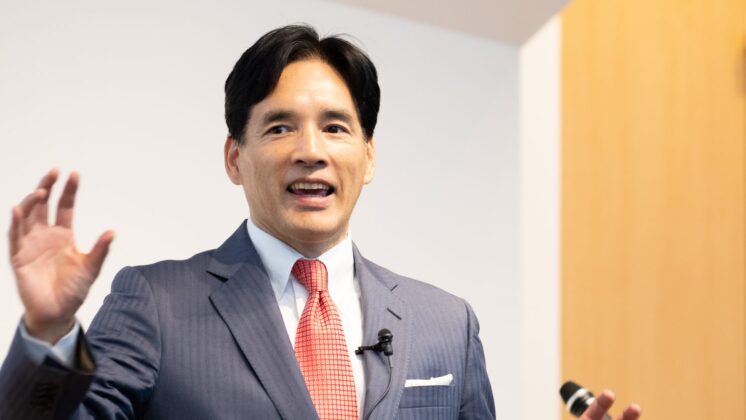“I am so thrilled that so many of my friends have come together today. This marks the fifth time the G1 Summit has been held. At the outset, I promised to continue holding the Summit for at least 10 years—I am just as committed to that. Indeed, the G1 Summit has been growing more and more with each year, rather than just continuing.”
These were my opening words at the beginning of the 5th G1 Summit. The content of the Summit was truly boosted this time. We even received a video message from Prime Minister Abe. Prominent figures who joined the Summit for the first this time this year included Mr. Shinjiro Koizumi, Ms. Shishu, Tsunku, Mr. Junichiro Kawaguchi, Mr. Hiroshi Senju, Mr. Kosuke Kitajima, and Mr. Atsuya Furuta. Defense Minister Itsunori Onodera joined the panel via video conference amid his busy schedule due to issues related to North Korea and the Senkaku Islands while Minister Masako Mori also addressed us. In addition to the two ministers, one deputy chief cabinet secretary, two vice ministers, five governors and seven mayors participated in the Summit. Altogether, nearly 300 participants and their families gathered in Urabandai in Fukushima Prefecture.
There are several factors that have helped the Summit become more powerful. The first factor is the establishment of subcommittees. After the session with Mr. Shigeru Ishiba and Mr. Seiji Maehara last year, the G1 Political Subcommittee was established. This resulted in a situation that saw Prime Minister Abe, LDP Chief Secretary Ishiba, Minister Onodera, Minister Hayashi, Deputy Chief Cabinet Secretary Seko in addition to the then Minister Hosono and the then Policy Research Council Chairman Maehara regularly gather at my house. Triggered by the Political Subcommittee, “subcommittees” on various fields started. The “Kyoto Camp” for G1 Local Governments held at the end of last year was joined by five governors and 12 mayors. Henceforth, G1 Media and G1 Bureaucrats came into existence.
The second factor was our events. Several other events have also kicked off. Following G1 Global, a conference conducted 100% in English, the G1 Executive Conference, which was primarily attended by executive officers or more senior managers in leading companies, was held in November 2012. Starting in 2013, G1 New Leaders Summit is scheduled to be held.
The third factor was our own growth as individuals. Professor Shinya Yamanaka, who is a board member of G1 and had spoken on stage at the G1 Summit four consecutive times (although he could not participate in the Summit this time), won the Nobel Prize. Mr. Shinzo Abe, who had participated in the G1 Summit in the past, became Prime Minister and Ms. Sakie Akiyama was elected as a member of the Industrial Competitiveness Council. Furthermore, G1 members have also been elected as the deputy chairman of KEIZAI DOYUKAI (Japan Association of Corporate Executives). This reflects the fact that our members have grown as individuals.
The spirit of G1 is described as “Proposals rather than criticism,” “From ideas to action” and “Self-awareness as a leader.” G1 has been operated under this spirit and thanks to that, we have cultivated a culture based on action.
One of the expressions I have started using at G1 is “responsibility of the generation.” The G1 generation is obliged to make Japan a better country for the sake of their children’s generation. Each of us individually may be powerless, however, anything becomes possible when leaders in all fields get together. Those with economic power contribute their money. Those with talent generate industries and create jobs. Those with political power conduct reforms. Those with fame use their influence. And, those with knowledge use this knowledge. If we combine all these aspects, I am confident we can make Japan a better country. If members of the G1 Summit do not do that, who will change Japan?
With that strong aspiration, I decided to make our “Action Statements” more succinct, based on our belief in “From ideas to action.” Discussions were conducted in five working groups on the utilization of women’s labor, information dissemination out of Japan, regional administration, politics and social entrepreneurs. At the final meeting, “G1 Action Statements” were to be adopted.
The main theme of this year’s G1 Summit was “the Reconstruction of Fukushima/Tohoku and the Re-building of Japan.” With Fukushima as a key topic, we have been focused on the reconstruction of Fukushima/Tohoku. The Fukushima Night and KIBOW Lunch were held in addition to “G1 Youth” with students from local high schools and universities.
I concluded my opening remarks by saying “As I just explained, there will be many things to look forward to during this Summit. G1 is for you all, including those watching the Summit on the Internet. I hope that you will enjoy the Summit, learn something, get stimulated and use G1 as a trigger to make Japan a better country. I hereby call the 5th G1 Summit to order.”
In the next column, I would like to introduce observations during the Summit with some video and photos. I sincerely hope that you will enjoy G1, learn something from it, get stimulated and use G1 as a trigger to make Japan a better country.
February 18, 2013
At my house in Ichiban-cho
Yoshito Hori



